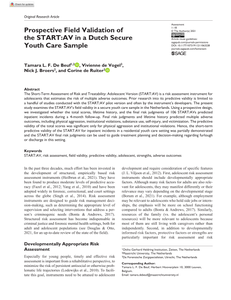This article focuses on the recent judgment of the Court of Justice, Aranyosi and Caldararu. After conducting a legal analysis on this case, three issues are identified and they are separately discussed in three sections. The aim of this paper is to show the impact of this judgment on public order and public security in Europe on the one hand and on the individual’s fundamental rights, on the other hand. It is going to be argued that even though there are limits to the principle of mutual recognition, this new exception based on fundamental rights establishes a new procedure for non-surrender. Therefore, the Court of Justice creates a non-execution ground which the EU legislator did not intend to include in the Framework Decision on the European arrest warrant. This is explained by looking at the three interconnected notions of Freedom, Security and Justice.
DOCUMENT

Uitspraak van het Europees Hof voor de Rechten van de Mens, met noot.
DOCUMENT

Background A high sedentary time is associated with increased mortality risk. Previous studies indicate that replacement of sedentary time with light- and moderate-to-vigorous physical activity attenuates the risk for adverse outcomes and improves cardiovascular risk factors. Patients with cardiovascular disease are more sedentary compared to the general population, while daily time spent sedentary remains high following contemporary cardiac rehabilitation programmes. This clinical trial investigated the effectiveness of a sedentary behaviour intervention as a personalised secondary prevention strategy (SIT LESS) on changes in sedentary time among patients with coronary artery disease participating in cardiac rehabilitation. Methods Patients were randomised to usual care (n = 104) or SIT LESS (n = 108). Both groups received a comprehensive 12-week centre-based cardiac rehabilitation programme with face-to-face consultations and supervised exercise sessions, whereas SIT LESS participants additionally received a 12-week, nurse-delivered, hybrid behaviour change intervention in combination with a pocket-worn activity tracker connected to a smartphone application to continuously monitor sedentary time. Primary outcome was the change in device-based sedentary time between pre- to post-rehabilitation. Changes in sedentary time characteristics (prevalence of prolonged sedentary bouts and proportion of patients with sedentary time ≥ 9.5 h/day); time spent in light-intensity and moderate-to-vigorous physical activity; step count; quality of life; competencies for self-management; and cardiovascular risk score were assessed as secondary outcomes. Results Patients (77% male) were 63 ± 10 years and primarily diagnosed with myocardial infarction (78%). Sedentary time decreased in SIT LESS (− 1.6 [− 2.1 to − 1.1] hours/day) and controls (− 1.2 [ ─1.7 to − 0.8]), but between group differences did not reach statistical significance (─0.4 [─1.0 to 0.3]) hours/day). The post-rehabilitation proportion of patients with a sedentary time above the upper limit of normal (≥ 9.5 h/day) was significantly lower in SIT LESS versus controls (48% versus 72%, baseline-adjusted odds-ratio 0.4 (0.2–0.8)). No differences were observed in the other predefined secondary outcomes. Conclusions Among patients with coronary artery disease participating in cardiac rehabilitation, SIT LESS did not induce significantly greater reductions in sedentary time compared to controls, but delivery was feasible and a reduced odds of a sedentary time ≥ 9.5 h/day was observed.
MULTIFILE

De African Digital Rights Network (ADRN) heeft een nieuw rapport gepubliceerd waarin de toevoer en verspreiding van digitale surveillance technologie in Afrika in kaart is gebracht. Onderzoeker Anand Sheombar van het lectoraat Procesinnovatie & Informatiesystemen is betrokken bij het ADRN-collectief en heeft samen met de Engelse journalist Sebastian Klovig Skelton, door middel van desk research de aanvoerlijnen vanuit Westerse en Noordelijke landen geanalyseerd. De bevindingen zijn te lezen in dit Supply-side report hoofdstuk van het rapport. APA-bronvermelding: Klovig Skelton, S., & Sheombar, A. (2023). Mapping the supply of surveillance technologies to Africa Supply-side report. In T. Roberts (Ed.), Mapping the Supply of Surveillance Technologies to Africa: Case Studies from Nigeria, Ghana, Morocco, Malawi, and Zambia (pp. 136-167). Brighton, UK: Institute of Development Studies.
MULTIFILE

The Short-Term Assessment of Risk and Treatability: Adolescent Version (START:AV) is a risk assessment instrument for adolescents that estimates the risk of multiple adverse outcomes. Prior research into its predictive validity is limited to a handful of studies conducted with the START:AV pilot version and often by the instrument’s developers. The present study examines the START:AV’s field validity in a secure youth care sample in the Netherlands. Using a prospective design, we investigated whether the total scores, lifetime history, and the final risk judgments of 106 START:AVs predicted inpatient incidents during a 4-month follow-up. Final risk judgments and lifetime history predicted multiple adverse outcomes, including physical aggression, institutional violations, substance use, self-injury, and victimization. The predictive validity of the total scores was significant only for physical aggression and institutional violations. Hence, the short-term predictive validity of the START:AV for inpatient incidents in a residential youth care setting was partially demonstrated and the START:AV final risk judgments can be used to guide treatment planning and decision-making regarding furlough or discharge in this setting.
DOCUMENT
